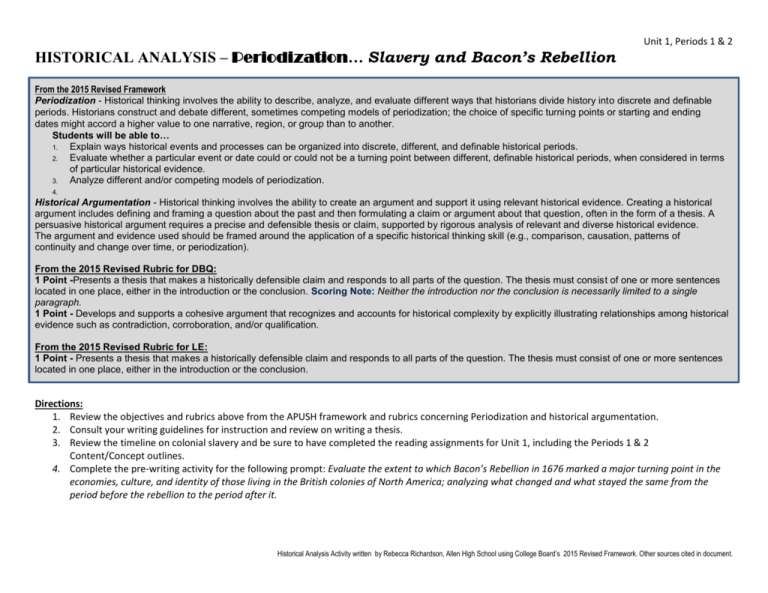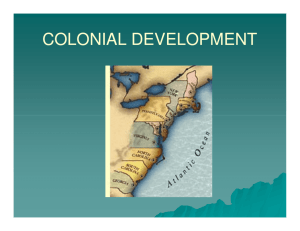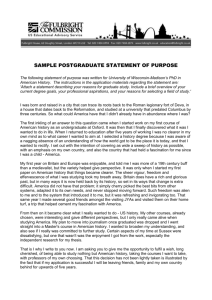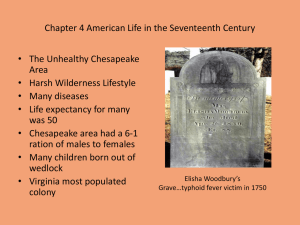Periodization… Slavery and Bacon's Rebellion
advertisement

Unit 1, Periods 1 & 2 HISTORICAL ANALYSIS – Periodization… Slavery and Bacon’s Rebellion From the 2015 Revised Framework Periodization - Historical thinking involves the ability to describe, analyze, and evaluate different ways that historians divide history into discrete and definable periods. Historians construct and debate different, sometimes competing models of periodization; the choice of specific turning points or starting and ending dates might accord a higher value to one narrative, region, or group than to another. Students will be able to… 1. Explain ways historical events and processes can be organized into discrete, different, and definable historical periods. 2. Evaluate whether a particular event or date could or could not be a turning point between different, definable historical periods, when considered in terms of particular historical evidence. 3. Analyze different and/or competing models of periodization. 4. Historical Argumentation - Historical thinking involves the ability to create an argument and support it using relevant historical evidence. Creating a historical argument includes defining and framing a question about the past and then formulating a claim or argument about that question, often in the form of a thesis. A persuasive historical argument requires a precise and defensible thesis or claim, supported by rigorous analysis of relevant and diverse historical evidence. The argument and evidence used should be framed around the application of a specific historical thinking skill (e.g., comparison, causation, patterns of continuity and change over time, or periodization). From the 2015 Revised Rubric for DBQ: 1 Point -Presents a thesis that makes a historically defensible claim and responds to all parts of the question. The thesis must consist of one or more sentences located in one place, either in the introduction or the conclusion. Scoring Note: Neither the introduction nor the conclusion is necessarily limited to a single paragraph. 1 Point - Develops and supports a cohesive argument that recognizes and accounts for historical complexity by explicitly illustrating relationships among historical evidence such as contradiction, corroboration, and/or qualification. From the 2015 Revised Rubric for LE: 1 Point - Presents a thesis that makes a historically defensible claim and responds to all parts of the question. The thesis must consist of one or more sentences located in one place, either in the introduction or the conclusion. Directions: 1. Review the objectives and rubrics above from the APUSH framework and rubrics concerning Periodization and historical argumentation. 2. Consult your writing guidelines for instruction and review on writing a thesis. 3. Review the timeline on colonial slavery and be sure to have completed the reading assignments for Unit 1, including the Periods 1 & 2 Content/Concept outlines. 4. Complete the pre-writing activity for the following prompt: Evaluate the extent to which Bacon’s Rebellion in 1676 marked a major turning point in the economies, culture, and identity of those living in the British colonies of North America; analyzing what changed and what stayed the same from the period before the rebellion to the period after it. Historical Analysis Activity written by Rebecca Richardson, Allen High School using College Board’s 2015 Revised Framework. Other sources cited in document. Unit 1, Periods 1 & 2 HISTORICAL ANALYSIS – Periodization… Slavery and Bacon’s Rebellion A thread on Slavery in America, through 1754 1503 Spanish and Portuguese begin replacing Native American slaves with African slaves in south America 1610 Dutch bring slaves to North America 1618 Headright System created in Jamestown (Indentured Servitude) The Indenture Contract in 17th Century Virginia - In return for passage to Virginia, the servant worked 7 years of labor and, by convention, an expectation of loyalty from the servant to the master. At the end of the term, master agreed (in indenture) to supply servant with "Freedom Dues" which included a suit of clothes, tobacco seed, perhaps some tools, and perhaps (unlikely) a small parcel of land. (Definition adapted from and graphic captured from http://roebuckclasses.com/201/colony/intro.htm) 1619 First African slaves arrive in Jamestown 1641 Body of Liberties, Massachusetts becomes the first colony to recognize slavery as legal 1651 Rhode Island declares an enslaved person must be freed after 10 years of service 1662 Slave Codes define slavery in racial terms and slaves as “chattel” (property) 1663 A Virginia court decides a child born to an enslaved mother is also a slave 1676 Bacon’s Rebellion, Virginia revolt of indentured servants 1688 A Minute Against Slavery Mennonites in Pennsylvania protest slavery 1712 New York City Slave Revolt, 12 whites killed, 21 blacks executed 1739 Stono Rebellion; South Carolina Slave Revolt, led by “Jemmy” 20 whites killed, 44 blacks executed, some tried to escape to Florida but were captured and sold to West Indies 1740 Negro Act (South Carolina) Response to Stono Rebellion, laws restricting slave assembly, education and movement, 10-year moratorium against importing African slaves, established penalties against slaveholders' harsh treatment of slaves, required legislative approval for manumissions (freeing one’s slaves), which slaveholders had previously been able to arrange privately. 1750 Georgia is the final colony to legalize slavery 1754 John Woolman (b. New Jersey 1720; d. York, England 1772) addresses his fellow Quakers in Some Consideration of the Keeping of Negroes and exerts great influence in leading the Society of Friends to recognize the evil of slavery. Historical Analysis Activity written by Rebecca Richardson, Allen High School using College Board’s 2015 Revised Framework. Other sources cited in document. Unit 1, Periods 1 & 2 HISTORICAL ANALYSIS – Periodization… Slavery and Bacon’s Rebellion Step #1 Read the question or prompt carefully: Read the question three times and be able to paraphrase the question and know the essential task demanded by it. Answering the question will be the central focus of your essay, and you want to be sure to ATFP: Prompt: Evaluate the extent to which Bacon’s Rebellion in 1676 marked a major turning point in the economies, culture, and identity of those living in the British colonies of North America; analyzing what changed and what stayed the same from the period before the rebellion to the period after it. What type of prompt is this? What are your parameters? What is your purpose? Step #2 Brainstorm on paper everything that comes to mind regarding the topic at hand. Aim for at least 10 specific things. What do you know about the topic? Put this down on paper to get your brain in gear for writing the essay. Once you have ample information, categorize it by theme. (ABC) 1. 6. 2. 7. 3. 8. 4. 9. 5. 10. Step #3 Clarify your thesis/view and identify an opposing view. Make sure your thesis ATFP! Don’t restate the prompt! Step #4 Write your introductory paragraph. USE THE FORMULA! Explain and Elaborate! ATFP! Enrichment: Discuss how to analyze the following events in a similar way (turning points): Pueblo Revolt, Metacom’s War, First Great Awakening, Enlightenment Historical Analysis Activity written by Rebecca Richardson, Allen High School using College Board’s 2015 Revised Framework. Other sources cited in document.










